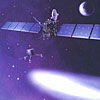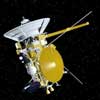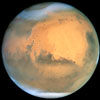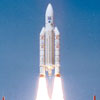|
Sunday:
November 25, 2001 | |
0001 GMT |
 |
What would happen if our Sun had a twin?
How would our Sun behave differently if it had a closely orbiting twin? While astronomers don't know the exact answer, NASA's Chandra X-ray Observatory has observed an intriguing star system that is beginning to provide important clues.
 FULL STORY FULL STORY
 |  |

|
 |
Tool for first comet orbiter will examine escaping gases
A lightweight NASA instrument from California has arrived in the Netherlands, one step closer in its journey to examine how gases escape from the nucleus of a comet. The Instrument will fly aboard the European Space Agency's major mission to a comet, called Rosetta.
 FULL STORY FULL STORY
 |  |

|
 |
|
Saturday:
November 24, 2001 | |
0020 GMT |
 |
Two satellites transmit data using laser light
This week, for the first time, a data link between satellites was established using a laser beam as signal carrier. On board Europe's Artemis satellite is the SILEX system, which provides an optical data transmission link with the French Earth observation satellite SPOT 4.
 FULL STORY FULL STORY
 |  |

|
 |
DAILY BRIEFING Other stories making news today
|
 |
New president named to lead Space Systems/Loral -- C. Patrick DeWitt has been named president of Space Systems/Loral and vice president of Loral Space & Communications, succeeding John M. Klineberg who is retiring from the company.
|
 |
|
Friday:
November 23, 2001 | |
0552 GMT |
 |
Comprehensive video preview now available
Space shuttle Endeavour is poised for launch next Thursday to ferry the Expedition Four resident crew to the International Space Station. Today we present 20 video clips for Spaceflight Now+Plus subscribers that preview the shuttle flight, the five-month Expedition mission and introduce the astronauts.
 FULL VIDEO COVERAGE FULL VIDEO COVERAGE
 NOT A SUBSCRIBER YET? NOT A SUBSCRIBER YET?
 |  |

|
 |
Sunlight may nudge asteroids toward Earth
Earth has long resided among swarms of asteroids. Many of these objects are large enough that an impact with Earth could present a significant hazard to life. Researchers believe that the starting location for these bodies is the main asteroid belt between the orbits of Mars and Jupiter. An on-going puzzle, however, is how these giant rocks escape the asteroid belt to reach orbits bound for Earth.
 FULL STORY FULL STORY
 |  |

|
 |
|
Thursday:
November 22, 2001 | |
0501 GMT |
 |
Mars Global Surveyor snaps its 100,000th image
Mars Global Surveyor was launched from Earth just over five years ago and entered orbit around the Red Planet a year later. After slightly more than four years in orbit, we have now received our 100,000th image from the craft's Mars Orbiter Camera.
 FULL STORY FULL STORY
 |  |

|
 |
Upgraded Ariane 5 solid rocket booster test fired
A test firing of a full-sized Ariane 5 solid rocket booster was performed Tuesday, marking an important step in Europe's plans to increase the rocket's payload capacity and to lower production expenses.
 FULL STORY FULL STORY
 |  |

|
 |
|
Wednesday:
November 21, 2001 | |
0449 GMT |
 |
SOHO solar probe reveals surprising gas near the Sun
The SOHO spacecraft has spotted mysterious clouds of gas falling towards the Sun that go against the fast-moving streams of gas that pour out continuously into space. The discovery promises a better understanding of the sources of the solar magnetism that envelops the Earth, quarrels with our own planet's field, and to some extent protects us from cosmic rays coming from the stars.
 FULL STORY FULL STORY
 |  |

|
 |
Cassini spacecraft to hunt for elusive gravity ripples
Barely perceptible fluctuations in the speed of a distant NASA spacecraft coasting away from Earth could provide science's first direct detection of gravitational waves, a basic feature of how the universe behaves.
 FULL STORY FULL STORY
 |  |

|
 |
|
Tuesday:
November 20, 2001 | |
1000 GMT |
 |
Evidence of Martian life dealt critical blow
When, in 1996, a group of NASA researchers presented several lines of evidence for fossil bacteria in a Martian meteorite, a wave of excitement passed through the public and the scientific community alike. That wave was followed by a storm of controversy. Now, new data and criticisms are coming from an Arizona State University research team.
 FULL STORY FULL STORY
 |  |

|
 |
Ariane 5 booster test firing at the Guiana Space Center
A test firing of an Ariane 5 solid rocket motor is to occur Tuesday on the booster test-stand at the Guiana Space Center, Europe's spaceport in Kourou, under the Ariane 5 Research and Technology Accompaniment program.
 FULL STORY FULL STORY
 |  |

|
 |
LockMart, TRW developing key military satellite
The U.S. Air Force has awarded Lockheed Martin and TRW a contract for up to $2.7 billion for the next phase of the Advanced EHF satellite program, which is the next generation of global, highly secure, survivable communications system for the military.
 FULL STORY FULL STORY
 |  |

|
 |
|
Monday:
November 19, 2001 | |
0358 GMT |
 |
New Australian telescope 'eyes' look at exploded star
Astronomers say that they have used a new receiving system on CSIRO's Australia Telescope to make the first image at short wavelengths of Supernova 1987A, the remains of an exploded star in a nearby galaxy. The picture marks another step in the telescope's progress to sharper eyesight.
 FULL STORY FULL STORY
 |  |

|
 |
5th Milstar military satellite shipped to launch site
Trumpeted as the U.S. military's most technologically advanced telecommunications satellite, the fifth Milstar spacecraft has arrived at Cape Canaveral Air Force Station to be readied for launch aboard a Titan 4B rocket.
 FULL STORY FULL STORY
 |  |

|
 |


 The Hubble Space Telescope's majestic view of the Eskimo Nebula. This spectacular poster is available now from the Astronomy Now Store.
The Hubble Space Telescope's majestic view of the Eskimo Nebula. This spectacular poster is available now from the Astronomy Now Store.